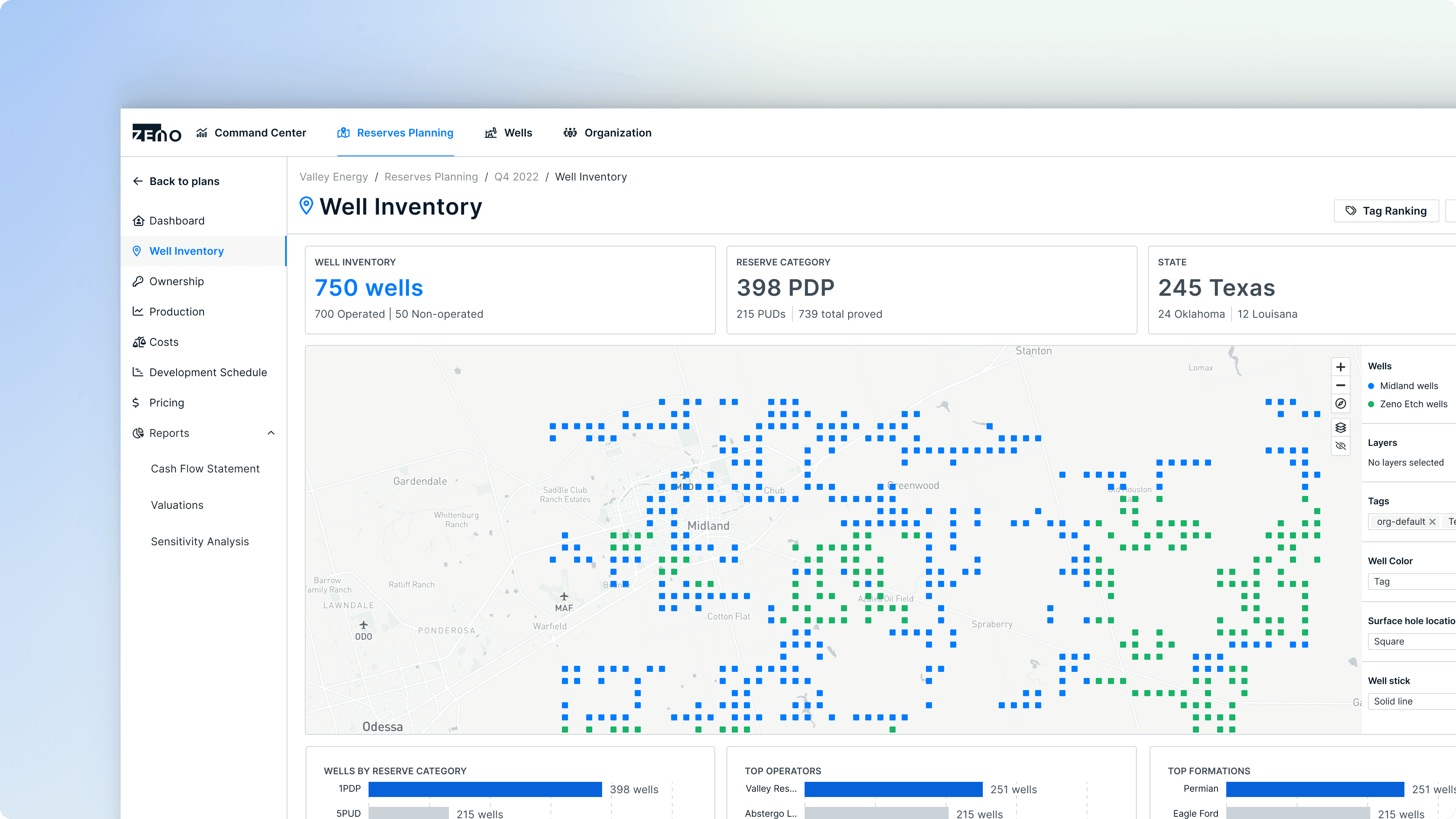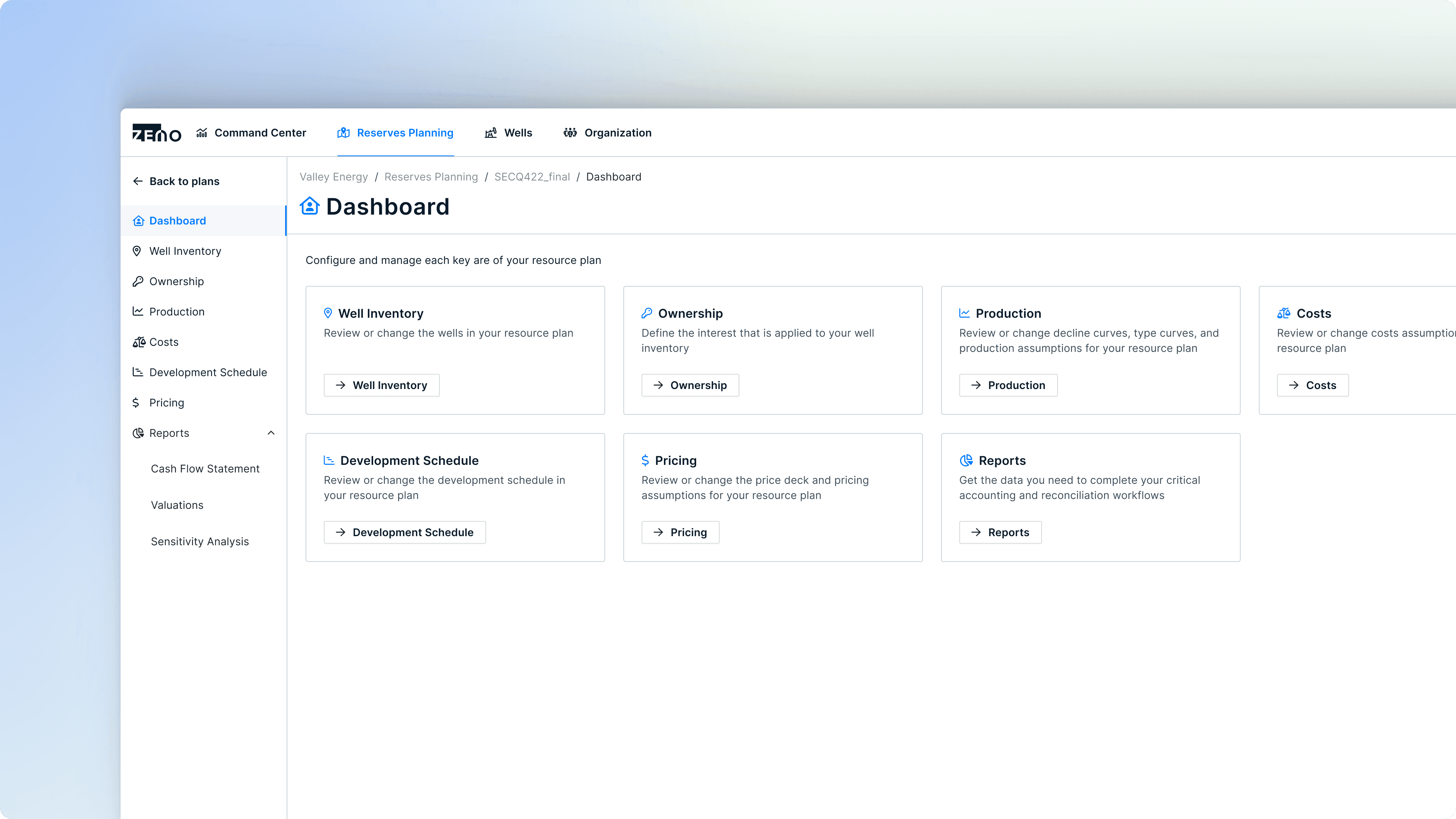Feb 11, 2023

Problem
E&P Operators were stuck with outdated asset management solutions that siloed teams, data, and insights into energy asset performance. Workflows and business processes were limited by the available technology, causing companies thousands of dollars in inefficiencies.
Outcome
Resource and Financial Planning enabled E&P Operators with a comprehensive solution to manage each key business area, enabling teams to have immediate and accurate performance data on key energy assets
Role
Principal Product Designer
Overview
E&P decision-makers need to have a baseline operating and unlevered cash flow forecast against which they can measure actual performance and run scenarios at any level of the business.
Problem Statement
The purpose of the Resource Planning in Zeno was to address the need for developing reserves plans, financial models, and conducting in-depth sensitivity and scenario analyses. The product aimed to ingest various data sources to ensure up-to-date information on production, costs, markets, and financial data. Key objectives included forecasting reserve volumes and building cash flow projection models. The goal was to enable accurate and comprehensive analysis of reserves, financial performance, and future cash flows, ultimately facilitating informed decision-making and strategic planning.
Users and Audience
The users and audience of the product consisted of finance teams, along with support staff across business development and operations, specifically targeting small to mid-cap Exploration and Production (E&P) Operators. These users typically had limited financial modeling experience and were seeking standardized models and data records. The product aimed to cater to their specific needs by providing a user-friendly and standardized platform that would streamline financial modeling processes, enhance data management, and enable more efficient and accurate analysis. By addressing these user requirements, the product aimed to empower finance teams and stakeholders involved in business development and operations, facilitating better decision-making, and improving overall financial performance within the E&P industry.
Roles and Responsibilities
My role was to lead the Product Design team, overseeing the creation of designs and user experience for the core of the Resource Planning and Financial Planning products. Additionally, I collaborated with the CTO in shaping the product roadmap, ensuring alignment with the overall vision. Working closely with a team of seven engineers, I facilitated scoping exercises, constraint discussions, and coordinated efforts for the product implementation. As Head of Product & Design, I reported directly to the CEO and provided regular status updates, while also fostering alignment with Sales, Marketing, and Customer Success teams. This collaborative approach allowed for effective cross-functional communication and ensured cohesive product launches.
Scope and Constraints
During the development of this product, several unique factors, scope considerations, and technical constraints shaped the project's scope. Integrating with legacy tools and data outputs was a significant aspect of the project, requiring seamless integration to ensure compatibility with existing systems. The challenge lay in translating diverse data and projects into a consumable Zeno plan, which demanded careful structuring and organization. Although the core plan areas were clearly defined, variations at the micro-level existed for each operator, making it challenging to establish a common standard. Throughout the project, close collaboration with accounting systems was maintained, with the aim of complementing rather than replacing accounting tools. The timing of working capital created gaps between actual and projected performance, highlighting the importance of addressing this discrepancy. These factors influenced the project's scope and required meticulous attention to detail and adaptability to meet the specific needs of each operator while aligning with the broader goals of the product.
Process and What Happened
Throughout the product development, we followed a simple framework to guide the project.
Understanding Existing Business Processes: Significant effort was devoted to thoroughly comprehending and analyzing the current business processes within small and mid-cap E&P operators. This involved extensive research and examination of their workflows, use cases, and challenges.
Identification of Common Workflows and Use Cases: Through this analysis, common patterns in the workflows and use cases of the operators were identified. This allowed for a deeper understanding of the problems they faced and the potential areas of improvement and opportunity.
Benchmarking Timeframes: The project involved benchmarking the time required for specific activities. This included assessing the time between scenario modeling requests and the generation of outputs, as well as the time between performance assessment and the identification of underlying factors influencing performance metrics.
Development of Operating Plans: Operators were required to create operating plans based on well inventories. This process involved configuring ownership decimals and joint interest agreements. Volumetric decline curve forecasts were used for production projections, and consideration was given to the inclusion of upside wells to understand their impact on future revenue and cash balances. Cost structures for each well were also incorporated to account for development and operational expenses.
Outcomes and Results
Throughout the project, several outcomes and valuable lessons surfaced, shaping the product experience. Notably, the implementation of the product brought about significant changes and benefits. Projections, which previously encountered lengthy turn-around times, were now readily available in real-time, enabling teams to make timely decisions based on the most current information. This shift allowed users to reclaim valuable time in their day, redirecting their efforts towards other crucial business objectives. Another notable outcome was the ability to aggregate data more efficiently, addressing a long-standing challenge faced by operators.
Reflecting on the project, it became evident that the implementation phase was a critical area for improvement. Streamlining this phase would further enhance the product's impact and user experience. In hindsight, these outcomes highlighted the importance of empowering users with real-time information and providing efficient data aggregation capabilities.
Moving forward, the lessons learned include recognizing the value of reducing turn-around times, constantly seeking the most current view of operating and financial plans, and prioritizing efforts to optimize the implementation process. By applying these insights, future iterations of the product can further enhance efficiency, improve user experiences, and align with the evolving needs of the operators.





